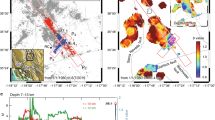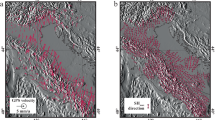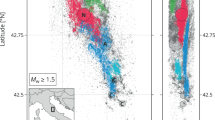Abstract
The occurrence of subduction zone earthquakes is primarily controlled by the state of stress on the interface between the subducting and overriding plates. This stress state is influenced by tectonic properties, such as the age of the subducting plate and the rate of plate motion1,2,3,4. It is difficult to directly measure stress on a plate interface. However, the stress state can be inferred using the Gutenberg–Richter relationship’s5 b-value, which characterizes the relative number of small compared to large earthquakes and correlates negatively with differential stress6,7,8,9,10,11,12,13. That is, a subduction zone characterized by relatively frequent large earthquakes has a low b-value and a high stress state. The b-value for subduction zones worldwide varies significantly14,15, but the source of this variance is unclear. Here we use the Advanced National Seismic System earthquake catalogue to estimate b-values for 88 sections in different subduction zones globally and compare the b-values with the age of the subducting plate and plate motions. The b-value correlates positively with subducting plate age, so that large earthquakes occur more frequently in subduction zones with younger slabs, but there is no correlation between b-value and plate motion. Given that younger slabs are warmer and more buoyant, we suggest that slab buoyancy is the primary control on the stress state and earthquake size distribution in subduction zones.
This is a preview of subscription content, access via your institution
Access options
Subscribe to this journal
Receive 12 print issues and online access
$259.00 per year
only $21.58 per issue
Buy this article
- Purchase on Springer Link
- Instant access to full article PDF
Prices may be subject to local taxes which are calculated during checkout




Similar content being viewed by others
References
Molnar, P. & Atwater, T. Interarc spreading and Cordilleran tectonics as alternates related to the age of subducted oceanic lithosphere. Earth Planet. Sci. Lett. 41, 330–340 (1978).
Ruff, L. & Kanamori, H. Seismicity and the subduction process. Phys. Earth Planet. Inter. 23, 240–252 (1980).
Ruff, L. & Kanamori, H. Seismic coupling and uncoupling at subduction zones. Tectonophysics 99, 99–117 (1983).
Scholz, C. H. & Campos, J. On the mechanism of seismic decoupling and back arc spreading at subduction zones. J. Geophys. Res. 100, 22103–22115 (1995).
Gutenberg, B. & Richter, C. F. Frequency of earthquakes in California. Bull. Seismol. Soc. Am. 34, 185–188 (1944).
Scholz, C. H. The frequency–magnitude relation of microfracturing in rock and its relation to earthquakes. Bull. Seismol. Soc. Am. 58, 399–415 (1968).
Goebel, T. H. W. et al. Identifying fault heterogeneity through mapping spatial anomalies in acoustic emission statistics. J. Geophys. Res. 117, B03310 (2012).
Goebel, T. H. W., Schorlemmer, D., Becker, T. W., Dresen, G. & Sammis, C. G. Acoustic emissions document stress changes over many seismic cycles in stick-slip experiments. Geophys. Res. Lett. 40, 2049–2054 (2013).
Spada, M., Tormann, T., Wiemer, S. & Enescu, B. Generic dependence of the frequency-size distribution of earthquakes on depth and its relation to the strength profile of the crust. Geophys. Res. Lett. 40, 709–714 (2013).
Schorlemmer, D., Wiemer, S. & Wyss, M. Variations in earthquake–size distribution across different stress regimes. Nature 437, 539–542 (2005).
Wiemer, S. & Wyss, M. Mapping the frequency–magnitude distribution in asperities: An improved technique to calculate recurrence times? J. Geophys. Res. 102, 15115–15128 (1997).
Ghosh, A., Newman, A. V., Thomas, A. M. & Farmer, G. T. Interface locking along the subduction megathrust from b-value mapping near Nicoya Peninsula, Costa Rica. Geophys. Res. Lett. 35, L01301 (2008).
Nanjo, K. Z., Hirata, N., Obara, K. & Kasahara, K. Decade-scale decrease in b value prior to the M9-class 2011 Tohoku and 2004 Sumatra quakes. Geophys. Res. Lett. 39, L20304 (2012).
Kagan, Y. Y. & Jackson, D. D. Tohoku earthquake: A surprise? Bull. Seismol. Soc. Am. 103, 1181–1194 (2013).
Tsapanos, T. M. b-values of two tectonic parts in the circum-Pacific belt. Pure Appl. Geophys. 134, 229–242 (1990).
Uyeda, S. & Kanamori, H. Back-arc opening and the mode of subduction. J. Geophys. Res. 84, 1049–1061 (1979).
Heuret, A., Conrad, C. P., Funiciello, F., Lallemand, S. & Sandri, L. Relation between subduction megathrust earthquakes, trench sediment thickness and upper plate strain. Geophys. Res. Lett. 39, L05304 (2012).
Ide, S. The proportionality between relative plate velocity and seismicity in subduction zones. Nature Geosci. 6, 780–784 (2013).
Bird, P. An updated digital model of plate boundaries. Geochem. Geophys. Geosyst. 4, 1027 (2003).
Woessner, J. & Wiemer, S. Assesing the quality of earthquake catalogues: Estimating the magnitude of completeness and its uncertainty. Bull. Seismol. Soc. Am. 95, 684–698 (2005).
Aki, K. Maximum likelihood estimate of b in the formula logN = a − bM and its confidence limits. Bull. Earthq. Res. Inst. Univ. Tokyo 43, 237–239 (1965).
Müller, R. D., Sdrolias, M., Gaina, C. & Roest, W. R. Age, spreading rates, and spreading asymmetry of the world’s ocean crust. Geochem. Geophys. Geosyst. 9, Q04006 (2008).
Argus, D. F., Gordon, R. G. & DeMets, C. Geologically current motion of 56 plates relative to the no-net-rotation reference frame. Geochem. Geophys. Geosyst. 12, Q11001 (2011).
Parsons, B. & Sclater, J. G. An analysis of the variation of ocean floor bathymetry and heat flow with age. J. Geophys. Res. 82, 803–827 (1977).
Smith, W. H. F. & Sandwell, D. T. Global sea floor topography from satellite altimetry and ship depth soundings. Science 277, 1956–1962 (1997).
Hilde, T. W. C. & Uyeda, S. in Geodynamics of the Western Pacific–Indonesian Region (eds Hilde, T. W. C. & Uyeda, S.) 75–89 (AGU, 1983).
Scholz, C. H. & Campos, J. The seismic coupling of subduction zones revisited. J. Geophys. Res. 117, B05310 (2012).
Gibowicz, S. J. Stress drop and aftershocks. Bull. Seismol. Soc. Am. 63, 1433–1446 (1973).
Ogata, Y. Statistical models for earthquake occurrences and residual analysis for point processes. J. Am. Stat. Assoc. 83, 9–27 (1988).
Zhuang, J., Ogata, Y. & Vere-Jones, D. Stochastic declustering of space–time earthquake occurrences. J. Am. Stat. Assoc. 97, 369–380 (2002).
Acknowledgements
This work was supported by JSPS KAKENHI (23244090) and MEXT KAKENHI (21107007). Figures were prepared using Generic Mapping Tool (Wessel and Smith, 1998).
Author information
Authors and Affiliations
Contributions
S.I. constructed a system for the statistical analysis of seismic sequences. T.N. analysed the data and wrote the paper.
Corresponding author
Ethics declarations
Competing interests
The authors declare no competing financial interests.
Supplementary information
Supplementary Information
Supplementary Information (PDF 3885 kb)
Supplementary Information
Supplementary Information (XLSX 61 kb)
Supplementary Information
Supplementary Information (XLSX 58 kb)
Rights and permissions
About this article
Cite this article
Nishikawa, T., Ide, S. Earthquake size distribution in subduction zones linked to slab buoyancy. Nature Geosci 7, 904–908 (2014). https://doi.org/10.1038/ngeo2279
Received:
Accepted:
Published:
Issue Date:
DOI: https://doi.org/10.1038/ngeo2279
This article is cited by
-
A review on slow earthquakes in the Japan Trench
Progress in Earth and Planetary Science (2023)
-
Variations in the crustal structure and strength of plate coupling along the Ryukyu subduction zone
Geoscience Letters (2023)
-
Regression analysis and variable selection to determine the key subduction-zone parameters that determine the maximum earthquake magnitude
Earth, Planets and Space (2023)
-
Aseismic slip and recent ruptures of persistent asperities along the Alaska-Aleutian subduction zone
Nature Communications (2022)
-
Subduction age and stress state control on seismicity in the NW Pacific subducting plate
Scientific Reports (2022)



